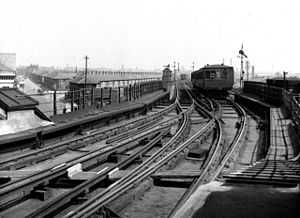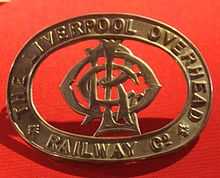Liverpool Overhead Railway

The Liverpool Overhead Railway opened in 1893 with lightweight electric multiple units in the Liverpool Docks, Lancashire, England. It was the world's first electric elevated railway and the first to use automatic signalling and electric colour light signals.[1] It was referred to locally as the Docker's Umbrella. In the early 1900s electric trains ran on the Lancashire and Yorkshire Railway to Southport and Aintree; special trains to Aintree ran twice a year after these regular services were withdrawn. A local railway, it was not nationalised in 1948. In 1955 a report into the structure of the many viaducts showed major repairs were needed that the company could not afford. The railway closed at the end of 1956 and the structures were dismantled in the following year.
History
Origins and construction
Liverpool Overhead Railway | |||||||||||||||||||||||||||||||||||||||||||||||||||||||||||||||||||||||||||||||||||||||||||||||||||||||||||||||||||||||||||||||||||||||||||||||||||||||||||||||||||||||||||||||||||||
|---|---|---|---|---|---|---|---|---|---|---|---|---|---|---|---|---|---|---|---|---|---|---|---|---|---|---|---|---|---|---|---|---|---|---|---|---|---|---|---|---|---|---|---|---|---|---|---|---|---|---|---|---|---|---|---|---|---|---|---|---|---|---|---|---|---|---|---|---|---|---|---|---|---|---|---|---|---|---|---|---|---|---|---|---|---|---|---|---|---|---|---|---|---|---|---|---|---|---|---|---|---|---|---|---|---|---|---|---|---|---|---|---|---|---|---|---|---|---|---|---|---|---|---|---|---|---|---|---|---|---|---|---|---|---|---|---|---|---|---|---|---|---|---|---|---|---|---|---|---|---|---|---|---|---|---|---|---|---|---|---|---|---|---|---|---|---|---|---|---|---|---|---|---|---|---|---|---|---|---|---|---|
Legend
| |||||||||||||||||||||||||||||||||||||||||||||||||||||||||||||||||||||||||||||||||||||||||||||||||||||||||||||||||||||||||||||||||||||||||||||||||||||||||||||||||||||||||||||||||||||
Rails had appeared in the Liverpool Docks in 1852, linking the warehouses and docks, but for many years horses were used and locomotives were banned because of the risk of fire.[2] From 1859 adapted horse omnibuses ran for passengers on these rails; they had wheel flanges that could be retracted to allow the vehicle to leave the rails and overtake a goods train. By the 1880s there was an omnibus service every five minutes.[3]
An elevated railway was suggested in 1852, and in 1878 the Mersey Docks and Harbour Board obtained powers for a single-line railway with passing loops at stations. However the Board of Trade condemned the plans and there was no further progress.[4] The Liverpool Overhead Railway Company was formed in 1888 and obtained permission for double-track railway in the same year.[5] Engineers Sir Douglas Fox and James Henry Greathead were commissioned to design the railway.[6] Steam traction was considered and the structure floored to prevent ash falling to the street below. However in 1891, electric traction was chosen; the City and South London Railway had opened with electric traction in 1890.[5]
The structure was to be made of wrought iron girders a nominal 16 feet (4.9 m) above the roadway. The standard gauge railway was laid on longitudinal timbers on the elevated sections. Hydraulic lifting sections were provided at Brunswick, Sandon and Langton Docks to allow goods access to the docks. To allow shipping access to the Leeds and Liverpool Canal, at Stanley Dock a bridge was replaced by a combined lifting and swing bridge, the lower lifting section carrying the road and goods railway.[6] At Brambley-Moore Dock the railway dropped to road level to pass under the Lancashire and Yorkshire Railway (L&YR) coal tip branch. As the gradient was 1 in 40 this was known as the switchback.[7] Approximately 5 miles (8.0 km) of railway was built from Alexandra Dock in the north to Herculaneum Dock in the south. The works commenced in 1889, and after 567 spans were erected, was completed in 1893.[8]
Originally the conductor rail was placed between the rails, energised at 500V dc. The power was supplied by a generating station at Bramley-Moore Dock that received its coal directly from the railway above.[9] Special lightweight passenger cars were designed with each having a driving motor car; one bogie was powered with a single 60 horsepower (45 kW) motor.[10] They were placed on the track in the switchback section.[7]
Opening

The railway was officially opened on 4 February 1893 by the Leader of the Opposition the Marquis of Salisbury and public services started on 6 March.[7] The railway gained the affectionate nickname of Dockers' Umbrella, as a great proportion was elevated and dockers could walk beneath it as they travelled around the docks.[11]
The line was extended northwards to Seaforth Sands on 30 April 1894. An extension southwards from Herculaneum Dock to Dingle was opened on 21 December 1896. Dingle was the only underground station, the extension from Herculaneum Dock being achieved with a 200 ft (61 m) lattice girder bridge and a half-mile (800 m) tunnel through the sandstone cliff to Park Road.[12]
In 1902 newer and more powerful electric motors were fitted to the trains in order to reduce service times in order to keep up with the competition from trams.[10] In the early 20th century the Lancashire and Yorkshire Railway L&YR was electrifying its routes out of Liverpool Exchange. A connection was built from the L&YR Seaforth & Litherland station to a new station beside Seaforth Sands. From 2 July 1905 LOR trains began to run through to Seaforth & Litherland.[13] To allow the though running of LY&R trains the conductor rail was moved to outside the running rails, the centre rail becoming the earth return until the 1920s. The L&YR built some special lightweight electric stock and from 1906 began running services from Dingle to Southport and Aintree.[13] Regular services to Aintree were withdrawn in 1908, and after this special trains ran only twice a year, on Jump Sunday and the following Friday for the Grand National, both held at Aintree Racecourse. Through services from Dingle to Southport were withdrawn in 1914.[14]
During World War II, the railway suffered extensively from bomb damage. As a purely local undertaking, it was not nationalised in 1948 with the rest of the British railway system. In the late 1940s and early 1950s, the company started to modernise some of the carriages, incorporating sliding doors. The line continued to carry large numbers of passengers, especially dock workers.
Closure
The railway was carried mainly on iron viaducts, with a corrugated iron decking onto which the tracks were laid. It was vulnerable to corrosion, especially as the steam-operated Docks Railway operated beneath some sections. In 1955 a survey discovered that repairs would be necessary in five years at a cost of £2 million. The company could not afford such costs and looked for financial support, including from the Liverpool City Council and the Mersey Docks and Harbour Board. None was forthcoming.[15] The company went into voluntary liquidation and despite considerable protest, the line was closed on the evening of 30 December 1956.[16] The service was replaced by a bus service operated by Liverpool Corporation.[17]
Demolition of the structure commenced in September 1957, completed the following year.[17] On 24 July 2012 a portion of the terminal tunnel near Dingle collapsed.[18]
Electric multiple units

The railway used electric units with passenger accommodation and an electric motor in the same unit. Any number could be coupled together with all motors controlled by the driver.[19] Built between 1892 and 1899 by Brown Marshall & Co, the original units had one 60 horsepower (45 kW) motor, but by the third batch this had been replaced by a 70 horsepower (52 kW) motor. In 1902 the motor cars were fitted with two 100 horsepower (75 kW) motors, and these were replaced in 1919 by 75 horsepower (56 kW) motors.[20] Air brakes were fitted, the pressure topped up at the termini.[21] In the early days a single motor coach ran off-peak, but the norm became a three-coach train consisting of two motor coaches with a trailer coach between.[10] Two classes of accommodation were provided, originally first and second, becoming first and third in 1905 when the L&YR began running over the railway.[22] The cars were open with transverse seating: the central trailer had leather-covered seats for first class passengers; third class passengers had wooden seating.[20] As the voltage was 500V, when they ran on the L&YR 630V system the motors had to be in series mode.[23]
In 1945-47 a three car train was modernised, replacing the timber body with aluminium and plywood and fitting power-operated sliding doors under control of the guard.[24] New trains were considered too expensive and six more trains were rebuilt.[25]
An original train was kept by the Museum of Liverpool[26] and a modernised carriage is stored at the Electric Railway Museum, Warwickshire.[27]
Film
The railway is featured in the film Waterfront (1950) and in the final scenes of the film The Clouded Yellow (1951), as the character played by Jean Simmons uses it to travel to one of the docks. Extensive archive footage appears in Of Time and the City, a "cinematic autobiographical poem" made by British film-maker Terence Davies[28] to celebrate Liverpool's 2008 reign as Capital of Culture. In 1897, the Lumière brothers filmed Liverpool,[29][30] including what is believed to be the first tracking shot, taken from the railway.
See also
- LYR Electric Units
- Railway electrification in Great Britain
- Architecture of Liverpool
References
Notes
- ↑ Liverpool Overhead Railway The Transport Trust
- ↑ Gahan 1982, p. 11.
- ↑ Gahan 1982, p. 12.
- ↑ Gahan 1982, pp. 12-13.
- ↑ 5.0 5.1 Gahan 1982, pp. 13-14.
- ↑ 6.0 6.1 Gahan 1982, p. 19.
- ↑ 7.0 7.1 7.2 Gahan 1982, p. 21.
- ↑ Gahan 1982, pp. 19-21.
- ↑ Gahan 1982, pp. 24-25, 34.
- ↑ 10.0 10.1 10.2 Gahan 1982, p. 30.
- ↑ "The Dockers' Umbrella: City railway served Liverpool's busy port". www.liverpoolecho.co.uk. Retrieved 25 January 2010.
- ↑ Gahan 1982, p. 21-22.
- ↑ 13.0 13.1 Gahan 1982, p. 23.
- ↑ Gahan 1982, pp. 23-24.
- ↑ Gahan 1982, p. 69.
- ↑ Gahan 1982, p. 70.
- ↑ 17.0 17.1 Gahan 1982, p. 72.
- ↑ "Tunnel collapse on Park Road sees homes evacuated in Liverpool". Liverpool echo. 24 July 2012. Retrieved 24 July 2012.
- ↑ "Trial Running and Inspection (reprinted)". Manchester Weekly Times. 13 January 1893. Retrieved 28 June 2012.
- ↑ 20.0 20.1 Gahan 1982, pp. 29-30.
- ↑ "Accident at Dingle 20 December 1898" (PDF). Railways Archive. Board of Trade. 26 January 1899. Retrieved 28 June 2012.
- ↑ Gahan 1982, p. 29.
- ↑ Gahan 1982, p. 34.
- ↑ Gahan 1982, p. 31.
- ↑ Gahan 1982, p. 32.
- ↑ "Liverpool Overhead Railway motor coach number 3, 1892". Museum of Liverpool. Retrieved 28 June 2012.
- ↑ "Liverpool Overhead Railway Car No. 7". Baginton, Warwickshire: Suburban Electric Railway Association. Retrieved 26 April 2011.
- ↑ Fairclough, Damon (2008). "Clutching at moments". .noise heat power. Retrieved 27 July 2013.
- ↑ Alexandre Promio (1897). Liverpool Scenes. 1:27 minutes: Lumière brothers.
- ↑ Koeck, Richard (2010). "Liverpool Overhead Railway archive film footage". National Museums Liverpool. Retrieved 27 July 2013.
Bibliography
- Gahan, John W. (1982). Seventeen Stations to Dingle. Countrywise. ISBN 0907768202.
Further reading
- Bolger, Paul (1992). The Docker's Umbrella, A History of Liverpool Overhead Railway. The Bluecoat Press. ISBN 1-872568-05-X.
- Box, Charles E. (1959). Liverpool Overhead Railway,1893-1956. Railway World Ltd.
External links
| Wikimedia Commons has media related to Liverpool Overhead Railway. |